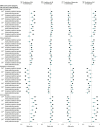Evaluation of Shared Genetic Susceptibility to High and Low Myopia and Hyperopia
- PMID: 33830181
- PMCID: PMC8033508
- DOI: 10.1001/jamaophthalmol.2021.0497
Evaluation of Shared Genetic Susceptibility to High and Low Myopia and Hyperopia
Abstract
Importance: Uncertainty currently exists about whether the same genetic variants are associated with susceptibility to low myopia (LM) and high myopia (HM) and to myopia and hyperopia. Addressing this question is fundamental to understanding the genetics of refractive error and has clinical relevance for genotype-based prediction of children at risk for HM and for identification of new therapeutic targets.
Objective: To assess whether a common set of genetic variants are associated with susceptibility to HM, LM, and hyperopia.
Design, setting, and participants: This genetic association study assessed unrelated UK Biobank participants 40 to 69 years of age of European and Asian ancestry. Participants 40 to 69 years of age living in the United Kingdom were recruited from January 1, 2006, to October 31, 2010. Of the total sample of 502 682 participants, 117 279 (23.3%) underwent an ophthalmic assessment. Data analysis was performed from December 12, 2019, to June 23, 2020.
Exposures: Four refractive error groups were defined: HM, -6.00 diopters (D) or less; LM, -3.00 to -1.00 D; hyperopia, +2.00 D or greater; and emmetropia, 0.00 to +1.00 D. Four genome-wide association study (GWAS) analyses were performed in participants of European ancestry: (1) HM vs emmetropia, (2) LM vs emmetropia, (3) hyperopia vs emmetropia, and (4) LM vs hyperopia. Polygenic risk scores were generated from GWAS summary statistics, yielding 4 sets of polygenic risk scores. Performance was assessed in independent replication samples of European and Asian ancestry.
Main outcomes and measures: Odds ratios (ORs) of polygenic risk scores in replication samples.
Results: A total of 51 841 unrelated individuals of European ancestry and 2165 unrelated individuals of Asian ancestry were assigned to a specific refractive error group and included in our analyses. Polygenic risk scores derived from all 4 GWAS analyses were predictive of all categories of refractive error in both European and Asian replication samples. For example, the polygenic risk score derived from the HM vs emmetropia GWAS was predictive in the European sample of HM vs emmetropia (OR, 1.58; 95% CI, 1.41-1.77; P = 1.54 × 10-15) as well as LM vs emmetropia (OR, 1.15; 95% CI, 1.07-1.23; P = 8.14 × 10-5), hyperopia vs emmetropia (OR, 0.83; 95% CI, 0.77-0.89; P = 4.18 × 10-7), and LM vs hyperopia (OR, 1.45; 95% CI, 1.33-1.59; P = 1.43 × 10-16).
Conclusions and relevance: Genetic risk variants were shared across HM, LM, and hyperopia and across European and Asian samples. Individuals with HM inherited a higher number of variants from among the same set of myopia-predisposing alleles and not different risk alleles compared with individuals with LM. These findings suggest that treatment interventions targeting common genetic risk variants associated with refractive error could be effective against both LM and HM.
Conflict of interest statement
Figures



References
-
- Chua SYL, Foster PJ. The Economic and Societal Impact of Myopia and High Myopia. In: Ang M, Wong TY, eds. Updates on Myopia: A Clinical Perspective. Springer Singapore; 2020:53-63. doi:10.1007/978-981-13-8491-2_3 - DOI
Publication types
MeSH terms
Grants and funding
LinkOut - more resources
Full Text Sources
Other Literature Sources
Medical

